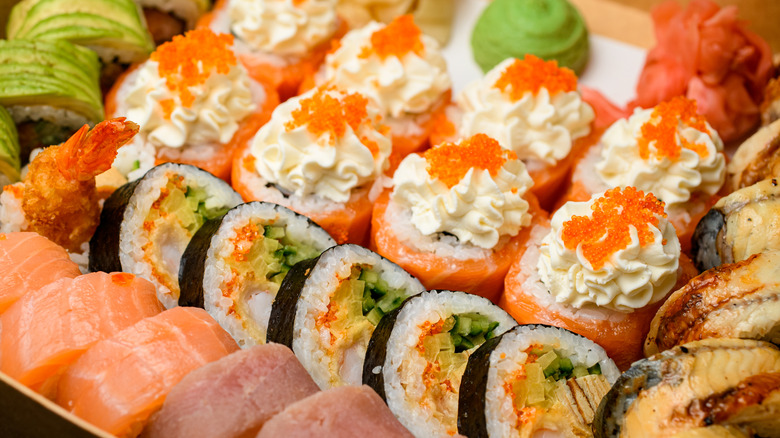What Is Tobiko And How Is It Different From Caviar?
We may receive a commission on purchases made from links.
Both tobiko and caviar are made from the eggs of fish. The former comes largely from a Japanese flying fish found in the waters surrounding (surprise) Japan, though other flying fish species exist all over the world. The eggs are less than a millimeter in size, preserved with salt, and commonly found in Japanese cuisine. Caviar, a much larger egg, is sourced from full-grown beluga, sevruga, and kaluga sturgeon. Flying fish roe has a smoky flavor and a crunchy texture while caviar has a more complex taste that can be savory, salty, and sometimes even buttery.
While fine caviar is best enjoyed on its own with a glass of Champagne, tobiko is normally eaten paired with other foods or used as a garnish. Both caviar and tobiko can be used in a variety of culinary settings, such as to improve scrambled eggs, studded in a light pasta sauce, or simply scooped over crackers or blini. (A scoop of tobiko or caviar also makes deviled eggs way better.) In addition to these uses, tobiko is also found throughout a variety of Japanese dishes, filling sushi or garnishing rolls, and adding a pop of color and a salty crunch to soups and sauces. But the differences between tobiko and caviar don't end there.
Tobiko is brighter (and cheaper) than caviar
Caviar is well known as being an expensive indulgence best savored on its own, while tobiko is a much more afforable fish roe product (a single ounce of Marky's Beluga Hybrid Black Caviar will currently set you back around $200, while eight ounces of Marky's Orange Tobiko only runs you $65, at the time of writing). This price difference is part of why tobiko is typically used to enhance a dish, rather than to stand as the star — but the distinctive colors of tobiko also play a role.
Caviar is associated with bronze, smoky gray, gold, and olive green hues. The flying fish roe, however, comes in many colors. It can be found in its natural brilliant reddish-orange color, but also in black, green, red, yellow, or gold! Different elements — like squid ink, wasabi, or beets — are often used to lend color to tobiko. But it is about more than just color. These additions to the tobiko also imbue it with interesting new flavors. For example, it is not hard to imagine how green tobiko, flavored with expensive authentic wasabi, would make a perfect sushi garnish.

